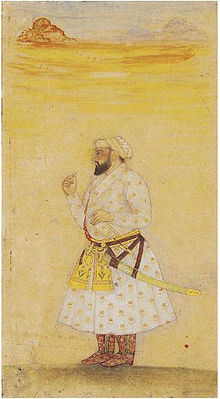গুৰু টেগ বাহাদুৰ
অৱয়ব
গুৰু টেগ বাহাদুৰ | |
|---|---|
 ১৮শ শতিকাৰ এখন চিত্ৰত গুৰু টেগ বাহাদুৰ | |
| ব্যক্তিগত | |
| জন্ম | (বাবা) ত্যাগ মল ১ এপ্ৰিল ১৬২১ |
| মৃত্যু | ২৪ নৱেম্বৰ ১৬৭৫ |
| মৃত্যুৰ কাৰণ | মুণ্ড ছেদন |
| ধৰ্ম | শিখ ধৰ্ম |
| দাম্পত্যসংগী | মাতা গুজৰী |
| সন্তান | গোবিন্দ সিং |
| পিতৃ-মাতৃ | গুৰু হৰগোবিন্দ আৰু মাতা নানকী |
| জনা যায় |
|
| ধৰ্মীয় জীৱনকাল | |
| কাৰ্যালয়ত সময় | ১৬৬৫ – ১৬৭৫ |
| পূৰ্বসূৰী | গুৰু হৰ কৃষাণ |
| উত্তৰসূৰী | গুৰু গোবিন্দ সিং |
টেগ বাহাদুৰ (১ এপ্ৰিল ১৬২১ - ২৪ নৱেম্বৰ ১৬৭৫)[4][5] আছিল দহজন শিখ ধৰ্মগুৰুৰ নৱম জন। ১৬২১ চনত অমৃতসৰত তেওঁৰ জন্ম হয়। তেওঁ গুৰু হৰ গোবিন্দ চাহিবৰ একেবাৰে সৰুজন সন্তান আছিল। জীৱিত অৱস্থাত ১৬৬৫ ৰ পৰা ১৬৭৫ চনলৈ তেওঁক গুৰু বুলি সম্বোধন কৰা হয়। গুৰু গ্ৰন্থ চাহিবত তেওঁৰ এশ পোন্ধৰটা শ্লোক সন্নিবিষ্ট আছে।
ঔৰংগজেৱৰ আদেশত গুৰু টেগ বাহাদুৰক গৰিহনা দিয়াৰ বহু তথ্য আছে। শিখ ঐতিহ্যত কোৱা হৈছে যে গুৰুৱে কাশ্মীৰী পাণ্ডীতসকলৰ অধিকাৰৰ বাবে থিয় হৈছিল, তেওঁ সম্ৰাটৰ সৈতে তেওঁলোকৰ পক্ষত পৰামৰ্শ ল'বলৈ তেওঁৰ ওচৰলৈ আহে আৰু তেওঁক অলপতে আৰোপ কৰা জিজিয়া শুল্ক প্ৰত্যাহাৰ কৰিবলৈ আহ্বান জনাই।[6] ইয়াৰ পিছতেই ৰজাৰ আদেশ নমনা আৰু ৰজাক প্ৰত্যাহ্বান জনোৱাৰ অপৰাধত ১৬৭৫ চনত দিল্লীত তেওঁক ৰাজহুৱা ভাৱে মৃত্যুদণ্ড দিয়া হয়।[7][8]
তথ্যসূত্ৰ
[সম্পাদনা কৰক]- ↑ Gill, Sarjit S., and Charanjit Kaur (2008), "Gurdwara and its politics: Current debate on Sikh identity in Malaysia", SARI: Journal Alam dan Tamadun Melayu, Vol. 26 (2008), pages 243-255, Quote: "Guru Tegh Bahadur died in order to protect the freedom of India from invading Mughals ."
- ↑ Singh, Darshan (2003). Martyrdom Of Guru Tegh Bahadur. প্ৰকাশক New Delhi: Anamika Publishers & Distributors (P) Limited. পৃষ্ঠা. 30, Quote: "Guru Tegh Bahadur, the ninth of the ten human Gurus of Sikhs, became a Martyr for the freedom of conscience and belief.". ISBN 9788179750322.
- ↑ Pechilis, Karen; Raj, Selva J. (2013). South Asian Religions: Tradition and Today. Routledge. পৃষ্ঠা. 228. ISBN 9780415448512. https://books.google.com/books?id=kaubzRxh-U0C&q=guru+tegh+bahadur+freedom+of&pg=PA228। আহৰণ কৰা হৈছে: 17 November 2016.
- ↑ W. H. McLeod (1984). Textual Sources for the Study of Sikhism. Manchester University Press. পৃষ্ঠা. 31–33. ISBN 9780719010637. https://books.google.com/books?id=Mj28AAAAIAAJ। আহৰণ কৰা হৈছে: 14 November 2013.
- ↑ "The Ninth Master Guru Tegh Bahadur (1621 - 1675)". sikhs.org. http://www.sikhs.org/guru9.htm। আহৰণ কৰা হৈছে: 23 November 2014.
- ↑ {cite book|author=Arvind-Pal Singh Mandair|title=Sikhism: A Guide for the Perplexed|url=https://books.google.com/books?id=vdhLAQAAQBAJ&pg=PA53%7Cyear=2013%7Cpublisher=Bloomsbury Academic|isbn=978-1-4411-0231-7|pages=53–54}, Quote: "The Guru's stance was a clear and unambiguous challenge, not to the sovereignty of the Mughal state, but to the state's policy of not recognizing the sovereign existence of Indians, their traditions and ways of life"
- ↑ "Religions - Sikhism: Guru Tegh Bahadur". BBC. http://www.bbc.co.uk/religion/religions/sikhism/people/teghbahadur.shtml। আহৰণ কৰা হৈছে: 20 October 2016.
- ↑ Pashaura Singh; Louis E. Fenech (2014). The Oxford Handbook of Sikh Studies. Oxford University Press. পৃষ্ঠা. 236–238. ISBN 978-0-19-969930-8. https://books.google.com/books?id=8I0NAwAAQBAJ.;
Fenech, Louis E. (2001). "Martyrdom and the Execution of Guru Arjan in Early Sikh Sources". Journal of the American Oriental Society (American Oriental Society) খণ্ড 121 (1): 20–31. doi:10.2307/606726.;
Fenech, Louis E. (1997). "Martyrdom and the Sikh Tradition". Journal of the American Oriental Society (American Oriental Society) খণ্ড 117 (4): 623–642. doi:10.2307/606445.;
McLeod, Hew (1999). "Sikhs and Muslims in the Punjab". South Asia: Journal of South Asian Studies (Taylor & Francis) খণ্ড 22 (sup001): 155–165. doi:10.1080/00856408708723379. ISSN 0085-6401.
